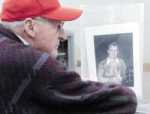TB treatment researcher is memorialized with portrait

SIKESTON - A painting and three plaques will soon be displayed at the Sikeston Library commemorating a Sikeston man's contribution to the battle against tuberculosis.
Glenn Harper was a teacher at Sikeston schools until 1980 but started his teaching career in New Mexico after receiving his bachelor's degree. While there, he decided to pursue his master's degree in physical education and biology at New Mexico Highlands University in Las Vegas, N.M., where he could study under a highly-recommended professor, Lora Mangum Shields.
"She was the head of the biology department and she was also a teacher of bacteriology," Harper said. "She was some teacher - what you would call a master teacher."
Harper said he started by majoring in physical education with a minor in biology. "They kept adding biology courses until I had two majors. They found out I was the best in biology - I had straight A's, I was the top student," he recalled.
The painting to be displayed at the library shows Harper with a syringe, some laboratory equipment and a guinea pig.
"We injected tuberculosis bacteria into guinea pigs," he explained. The researchers then tested various medicines. "They were looking to see which ones would live and which ones would die. The medication I had in my syringe didn't work. My guinea pig died," Harper said.
Autopsies were performed on the guinea pigs that died. "We made slides of all their internal organs," Harper said.
It was advanced research that only graduate students were permitted to participate in, according to Harper. "It was not supervised or anything," he said. "We were given written instructions on the research that would take place."
Harper said there was one additional memorable event from that course: "The other graduate students asked me to identify their 'unknowns' and I told them what I thought they were," he said. "When the class met, Dr. Shields made an announcement. She said, 'For the first time in the history of this university, all of the graduate students got all of their unknowns perfectly identified - no mistakes. Aren't we proud of our graduate students?' But I was the one that actually did it."
Harper did consider a research career and even applied for a state bacteriologist job in California but was advised he did not have enough of a background in math and chemistry.
Additionally, as he had to take care of his mother and older brother, he decided, "I had better just go and teach."
Harper said it was rewarding seeing the influence his teaching has had on his students but he is also proud of his contribution to combating what used to be a feared disease.
Once known as "consumption," documentation and evidence of TB goes back to ancient Greece and Egypt. For centuries the disease was thought to always be fatal until the sanatorium cure was developed.
In the early 1940s, chemotherapy was successfully used to combat the disease for the first time, but resistant mutations soon appeared. This was countered by using combinations of drugs researched from the late 1940s on up into the 1960s - which is part of the process Harper participated in.
"He had a photograph of himself. It was just a black and white photo but he wanted a portrait of it based on the photograph," said Catherine Camden who was commissioned to do the painting. "I had to imagine the colors; I had to research guinea pigs, see what color they are."
The painting's composition, however, is fairly close to the photograph. "There are a few elements in the photo that I didn't put in the painting," she said, such as removing some background elements for a more classic look.
Camden said she usually paints portraits of live people but has often been commissioned to do other portraits of people from the past using photographs.
"He is really proud of his accomplishment and this painting of the photograph kind of documents what he did," Camden said. "He contributed to the defeat of the tuberculosis which was an important accomplishment. We should be proud of him."
The painting will be put on display after it is finished being framed.

